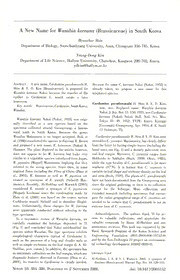
A New Name for Wasabia koreana (Brassicaceae) in South Korea PDF
Preview A New Name for Wasabia koreana (Brassicaceae) in South Korea
A New Name for Wasabia koreana (Brassicaceae) in South Korea Hyunchur Shin Department of Biology, Soonchunhyang University, Asan, Chungnam 336-745, Korea Young-Dong Kim Department of Life Science, Hallym University, Chunchon, Kangwon 200-702, Korea. [email protected] Abstract. A new name, Cardaminepseudowasabi H. Because the name C. koreana Nakai (Nakai. 1952) is Shin & Y. D. Kim (Brassicaceae), is proposed for Wasabia koreana Nakai because the transfer of the misplaced species. epithet to Cardamine L. would create a later homKeoyn ywmo. rds: Brassicaceae, Cardamine, South Korea, Cardnaommi.n en opvs. euRdeopwlaacseadb in aHm. eS: hiWn a&sa bYia. Dk.o rKeaimna, Nakai, J. Jap. Bot. 11: 150. 1935, non Cardamine rnoaylWlayl asdtaoebmsiacb r ikboienrd e aSnaoasu tNha akKnaeiow re( Nas.a pkeaBciie,e csa1 u9s3be5a )s et he fagmenouuss Tk1[G3oo yrke(eyhaooonn lago3 gt1yi(]:Np: eaG4,k 9wTa.iI a)) n.1 gN9r5ea2uk.na gi,T, YABPpuErl.l :. 19KN3oa4tr,le .a R..S cKKi.. y SuMmnguitgshi. Wasabia Matsumura is no longer accepted, Baik et al. (1986) transferred the species to Eutrema R. Brown resembles C. yezoensis Maximowicz, but clearly differs and proposed a new name, E. koreanum (Nakai) K. from the latter by having simple leaves (including the Hammer. The plant depicted in the articdo, however, basal ones; sec Fig. 1) and a densely pubescent stem does not appear to be W. koreana but looks very and leaf margin. Moreover, C. yezoensis ranges from similar to a vegetable species introduced from Japan, Hokkaido to Sakhalin (Bush, 1939; Ohwi, 1985), W. japonica (Miquel) Matsumura, implying that they while the type locality of C. pseudowasabi is far more referred to the wrong species. Since then, in some southern (37CN). It is known that C. yezoensis is al., 2001), W. koreana as well as W. japonica are and stem (Bush, 1939). The plants of C. pseudowasabi imowiez. Recently, Al-Shehbaz and Warwick (2005) since the original gathering, so there is no collection considered E. wasabi a synonym of E. japonicum except for the holotype. More collections and (Miquel) Koidzumi since the combination made by extended research including specimens that encom¬ Zhou et al. (2001) was based on the nomen nudum pass the entire geographical range of C. yezoensis are needed to be certain that C. pseudowasabi is not an mate. Unfortunately, these changes for W. koreana were apparently conducted without referring to the type specimen. Acknowledgments. The authors thank TI for ac¬ In a taxonomic review of Wasabia koreana, we cess to valuable collections, and appreciate the carefully examined the hololype deposited in TI valuable comments by Ihsan Al-Shehbaz and one (Fig. 1) and concluded that Nakai misidentified the anonymous reviewer. This work was supported by the i Wasabia. The type specimen exhibits Basic Research Program of the 1 morphological characters typical of Cardamine L. Engineering Foundation (R01-2004-000-10712-0) and by the Eco-Technopia 21 project on environmen¬ well as simple trichomes on the leaf margin (I. A. Al- tal technology development (05002-0028-0). Shehbaz, pers. comm.). In addition, the specimen has no mucronate callosities on the leaf margin, which are diagnostic features observed in Eutrema (Zhou et al., 2001). Its transfer to Cardamine is clearly needed. Eutrema (Brassicaceae). Harvard Pap. Bot. 10: 129-1,15. Novon 18: 384-386. Published on September 2008. doi: 10.3417/2005152 Volume 18, Number 3 Shin & Kim 2008 New name for Wasabia koreana (Brassicaceae)
